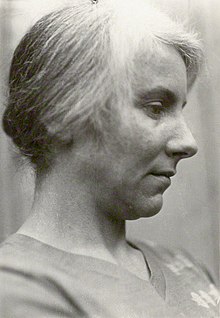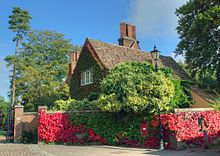Rupert Chawner Brooke (middle name sometimes given as "Chaucer"; 3 August 1887 â€" 23 April 1915) was an English poet known for his idealistic war sonnets written during the First World War, especially "The Soldier". He was also known for his boyish good looks, which were said to have prompted the Irish poet W. B. Yeats to describe him as "the handsomest young man in England".
Early life

Brooke was born at 5 Hillmorton Road, Rugby, Warwickshire, the second of the three sons of William Parker Brooke, a Rugby schoolmaster, and Ruth Mary Brooke, née Cotterill. He was educated at two independent schools in Rugby: Hillbrow School and Rugby School. In 1905, he became friends with St. John Lucas, who thereafter became something of a mentor to him.
While travelling in Europe he prepared a thesis, entitled "John Webster and the Elizabethan Drama", which won him a scholarship to King's College, Cambridge, where he became a member of the Cambridge Apostles, was elected as President of the Cambridge University Fabian Society, helped found the Marlowe Society drama club and acted in plays including the Cambridge Greek Play.
Life and career
Brooke made friends among the Bloomsbury group of writers, some of whom admired his talent while others were more impressed by his good looks. Virginia Woolf boasted to Vita Sackville-West of once going skinny-dipping with Brooke in a moonlit pool when they were in Cambridge together.
Brooke belonged to another literary group known as the Georgian Poets and was one of the most important of the Dymock poets, associated with the Gloucestershire village of Dymock where he spent some time before the war. He also lived in the Old Vicarage, Grantchester.
Brooke suffered a severe emotional crisis in 1912, caused by sexual confusion and jealousy, resulting in the breakdown of his long relationship with Ka Cox (Katherine Laird Cox). Brooke's paranoia that Lytton Strachey had schemed to destroy his relationship with Cox by encouraging her to see Henry Lamb precipitated his break with his Bloomsbury group friends and played a part in his nervous collapse and subsequent rehabilitation trips to Germany.
As part of his recuperation, Brooke toured the United States and Canada to write travel diaries for the Westminster Gazette. He took the long way home, sailing across the Pacific and staying some months in the South Seas. Much later it was revealed that he may have fathered a daughter with a Tahitian woman named Taatamata with whom he seems to have enjoyed his most complete emotional relationship. Many more people were in love with him. Brooke was romantically involved with the actress Cathleen Nesbitt and was once engaged to Noël Olivier, whom he met, when she was aged 15, at the progressive Bedales School.
Brooke was an inspiration to poet John Gillespie Magee, Jr., author of the poem "High Flight". Magee idolised Brooke and wrote a poem about him ("Sonnet to Rupert Brooke"). Magee also won the same poetry prize at Rugby School which Brooke had won 34 years earlier.
As a war poet Brooke came to public attention in 1915 when The Times Literary Supplement quoted two of his five sonnets ("IV: The Dead" and "V: The Soldier") in full on 11 March and his sonnet "V: The Soldier" was read from the pulpit of St Paul's Cathedral on Easter Sunday (4 April). Brooke's most famous collection of poetry, containing all five sonnets, 1914 & Other Poems, was first published in May 1915 and, in testament to his popularity, ran to 11 further impressions that year and by June 1918 had reached its 24th impression; a process undoubtedly fuelled through posthumous interest.
Death

Brooke's accomplished poetry gained many enthusiasts and followers and he was taken up by Edward Marsh who brought him to the attention of Winston Churchill, then First Lord of the Admiralty. He was commissioned into the Royal Naval Volunteer Reserve as a temporary Sub-Lieutenant shortly after his 27th birthday and took part in the Royal Naval Division's Antwerp expedition in October 1914. He sailed with the British Mediterranean Expeditionary Force on 28 February 1915 but developed sepsis from an infected mosquito bite. He died at 4:46Â pm on 23 April 1915 in a French hospital ship moored in a bay off the island of Skyros in the Aegean on his way to the landing at Gallipoli. As the expeditionary force had orders to depart immediately, he was buried at 11Â pm in an olive grove on Skyros, Greece. The site was chosen by his close friend, William Denis Browne, who wrote of Brooke's death:
...I sat with Rupert. At 4 o’clock he became weaker, and at 4.46 he died, with the sun shining all round his cabin, and the cool sea-breeze blowing through the door and the shaded windows. No one could have wished for a quieter or a calmer end than in that lovely bay, shielded by the mountains and fragrant with sage and thyme.
His grave remains there today. Another friendâ€"and war poetâ€"Patrick Shaw-Stewart, also played a prominent role in Brooke's funeral. On 11 November 1985, Brooke was among 16 First World War poets commemorated on a slate monument unveiled in Poets' Corner in Westminster Abbey. The inscription on the stone was written by a fellow war poet, Wilfred Owen. It reads: "My subject is War, and the pity of War. The Poetry is in the pity."
The original wooden cross that marked his grave on Skyros, which was painted and carved with his name, was removed to Clifton Road Cemetery in Rugby, Warwickshire, to the Brooke family plot. When a permanent memorial was made for his grave on Skyros, Rupert Brooke's mother, Mary Ruth Brooke, had the original cross brought from Skyros to Rugby and placed at the plot. However, because of perishing in the open air, it was removed from the cemetery in 2008, and replaced by a more permanent marker. The original grave marker from Skyros is now at Rugby School with the memorials of other old Rugbeians.
Brooke's brother, 2nd Lt. William Alfred Cotterill Brooke, was a member of the 8th Battalion London Regiment (Post Office Rifles) and was killed in action near Le Rutoire Farm on 14 June 1915 aged 24. He is buried in Fosse 7 Military Cemetery (Quality Street), Mazingarbe, Pas de Calais, France. He had only joined the battalion on 25 May.
In popular culture

- John Ireland set "The Soldier" and "Blow Out, You Bugles" for voice and piano in his 1918 song collection Two Songs.
- This Side of Paradise, by F. Scott Fitzgerald, opens with the quotation "Well this side of Paradise!… There's little comfort in the wise. â€" Rupert Brooke". Rupert Brooke is also referenced in other parts of the book.
- Danny Kirwan used the first two verses of the poem "Dust" as the lyrics of the song of the same name on the 1972 Fleetwood Mac album Bare Trees without crediting Brooke.
- The M*A*S*H episode "Springtime" features his poems "A Channel Passage" and "Love", read by Cpl. Radar O'Reilly.
- The 2009 novel The Great Lover, by Jill Dawson, is based on Brooke's life and mixes fact with fiction. The title is taken from one of Brooke's poems of the same name.
- A.S. Byatt's 2009 novel The Children's Book centers on a social circle in which Brooke makes periodic appearances.
- The 2011 novel The Stranger's Child by Booker Prizeâ€"winning British novelist Alan Hollinghurst features fictional War Poet Cecil Valance who shares characteristics of, though is not as talented as, Brooke.
- The stage play The Hive by Australian playwright Sam Sejavka is a surreal play about the death of Rupert Brooke, directed by Robert Chuter, produced at La Mama Theatre, Melbourne 1989. The play won the Premier Literary Award and was nominated for three Green Room Awards, Melbourne, Australia.
- In the novel Point Counter Point by Aldous Huxley, a character criticizes Rupert Brooke for his idealistic view of war and calls him "a spoilt and blase member of the leisured class".
See also
- List of Bloomsbury Group people
References
Further reading

- Brooke, Rupert, Letters From America with a Preface by Henry James (London: Sidgwick & Jackson, Ltd, 1931; repr. 1947).
- Dawson, Jill, The Great Lover (London: Sceptre, 1990). A historical novel about Brooke and his relationship with a Tahitian woman, Taatamata, in 1913â€"14 and with Nell Golightly a maid where he was living.
- Halliburton, Richard, The Glorious Adventure (New York and Indianapolis: Bobbs-Merrill, 1927). Traveller/travel writer Halliburton, in recreating Odysseus' adventures, visits the grave of Brooke on the Greek island of Skyros.
- Keith Hale, ed. Friends and Apostles: The Correspondence of Rupert Brooke-James Strachey, 1905â€"1914.
- Gerry Max, Horizon Chasers â€" The Lives and Adventures of Richard Halliburton and Paul Mooney (McFarland, c2007). References are made to the poet throughout. Quoted, p. 11.
- Gerry Max, "'When Youth Kept Open House' â€" Richard Halliburton and Thomas Wolfe", North Carolina Literary Review, 1996, Issue Number 5. Two early 20th century writers and their debt to the poet.
- Morley, Christopher, "Rupert Brooke" in Shandygaff â€" A number of most agreeable Inquirendoes upon Life & Letters, interspersed with Short Stories & Skits, the Whole Most Diverting to the Reader (New York: Garden City Publishing Company, 1918), pp. 58â€"71. An important early reminiscence and appraisal by famed essayist and novelist Morley.
- Sellers Leonard. The Hood Battalion - Royal Naval Division. Leo Cooper, Pen & Sword Books Ltd. 1995, Select Edition 2003 ISBN 978-1-84468-008-5 - Rupert Brooke was an officer of Hood Battalion, 2nd Brigade, Royal Naval Division.
- Arthur Springer. Red Wine of Youthâ€"A Biography of Rupert Brooke (New York: Bobbs-Merrill, 1952). Partly based on extensive correspondence between American travel writer Richard Halliburton and the literary and salon figures who had known Brooke.
- Christopher Hassall. "Rupert Brooke: A Biography" (Faber and Faber 1964)
- Sir Geoffrey Keynes, ed. "The Letters of Rupert Brooke" (Faber and Faber 1968)
- Colin Wilson. "Poetry & Mysticism" (City Lights Books 1969). Contains a chapter about Rupert Brooke.
- John Lehmann. "Rupert Brooke: His Life and His Legend" (George Weidenfield and Nicolson Ltd 1980)
- Paul Delany. "The Neo-Pagans: Friendship and Love in the Rupert Brooke Circle" (Macmillan 1987)
- Mike Read. "Forever England: The Life of Rupert Brooke" (Mainstream Publishing Company Ltd 1997)
- Nigel Jones. "Rupert Brooke: Life, Death and Myth" (Metro Books,1999)
- Timothy Rogers. "Rupert Brooke: A Reappraisal and Selection" (Routledge, 1971)
- Robert Scoble. The Corvo Cult: The History of an Obsession (Strange Attractor, 2014)
- Christian Soleil. "Rupert Brooke: Sous un ciel anglais" (Edifree, France, 2009)
- Christian Soleil. "Rupert Brooke: L'Ange foudroyé" (Monpetitediteur, France, 2011)
External links

- Rupert Brooke Remembered
- Rupert Brooke Society
- Rupert Brooke on Skyros
- Works by Rupert Brooke at Project Gutenberg
- Works by or about Rupert Brooke at Internet Archive
- Works by Rupert Brooke at LibriVox (public domain audiobooks)
- Poetry Archive: 150 poems of Rupert Brooke
- Bartleby.com â€" Collected Poems
- Rupert Brooke at the Commonwealth War Graves Commission database
- Elizabeth Whitcomb Houghton Collection, containing letters by Brooke
- 12 September 1915, New York Times, A Genius Whom the War Made and Killed; Rupert Brooke's Death at the Front Illustrates the Paradox of the Effect on Literature of War, Which Ended His Career and Made Him Immortal
- Lost Poets of the Great War, a hypertext document on the poetry of World War I by Harry Rusche, of the English Department, Emory University, Atlanta, Georgia. It contains a bibliography of related materials.
- Edward Winter, Rupert Brooke and Chess
- Dymock Poets Archive University of Gloucestershire Archives and Special Collections
- Name Brooke, Rupert Chaucer or Chawner Rank or Rating: Sub Lieutenant, full service record at The National Archives (fee required to download)

